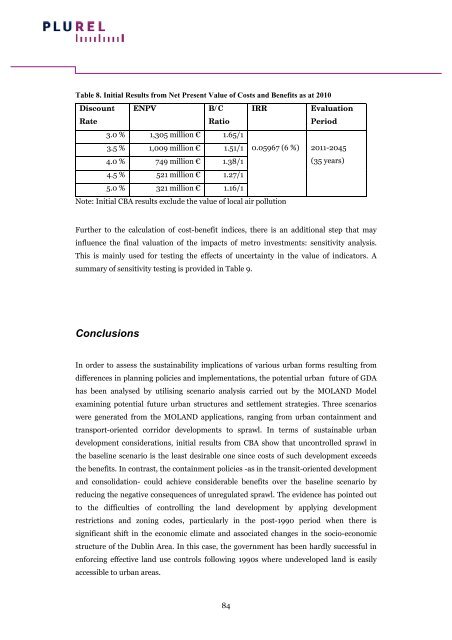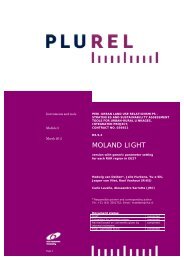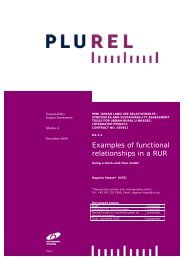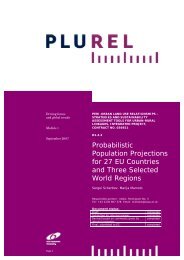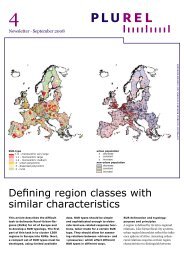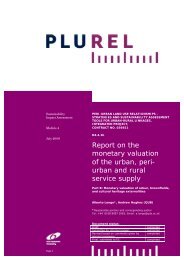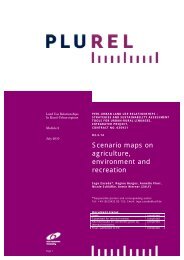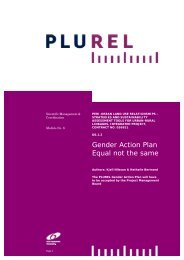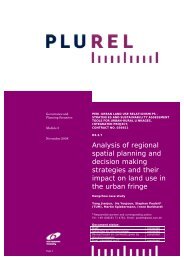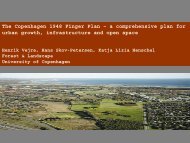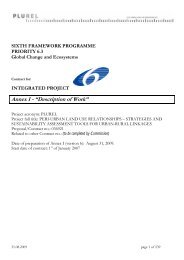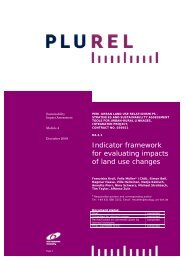Cost benefit analysis of peri-urban land use policy - Plurel
Cost benefit analysis of peri-urban land use policy - Plurel
Cost benefit analysis of peri-urban land use policy - Plurel
Create successful ePaper yourself
Turn your PDF publications into a flip-book with our unique Google optimized e-Paper software.
Table 8. Initial Results from Net Present Value <strong>of</strong> <strong>Cost</strong>s and Benefits as at 2010<br />
Discount<br />
Rate<br />
ENPV<br />
B/C<br />
Ratio<br />
IRR<br />
Evaluation<br />
Period<br />
3.0 % 1,305 million € 1.65/1<br />
3.5 % 1,009 million € 1.51/1 0.05967 (6 %) 2011-2045<br />
4.0 % 749 million € 1.38/1<br />
(35 years)<br />
4.5 % 521 million € 1.27/1<br />
5.0 % 321 million € 1.16/1<br />
Note: Initial CBA results exclude the value <strong>of</strong> local air pollution<br />
Further to the calculation <strong>of</strong> cost-<strong>benefit</strong> indices, there is an additional step that may<br />
influence the final valuation <strong>of</strong> the impacts <strong>of</strong> metro investments: sensitivity <strong>analysis</strong>.<br />
This is mainly <strong>use</strong>d for testing the effects <strong>of</strong> uncertainty in the value <strong>of</strong> indicators. A<br />
summary <strong>of</strong> sensitivity testing is provided in Table 9.<br />
Conclusions<br />
In order to assess the sustainability implications <strong>of</strong> various <strong>urban</strong> forms resulting from<br />
differences in planning policies and implementations, the potential <strong>urban</strong> future <strong>of</strong> GDA<br />
has been analysed by utilising scenario <strong>analysis</strong> carried out by the MOLAND Model<br />
examining potential future <strong>urban</strong> structures and settlement strategies. Three scenarios<br />
were generated from the MOLAND applications, ranging from <strong>urban</strong> containment and<br />
transport-oriented corridor developments to sprawl. In terms <strong>of</strong> sustainable <strong>urban</strong><br />
development considerations, initial results from CBA show that uncontrolled sprawl in<br />
the baseline scenario is the least desirable one since costs <strong>of</strong> such development exceeds<br />
the <strong>benefit</strong>s. In contrast, the containment policies -as in the transit-oriented development<br />
and consolidation- could achieve considerable <strong>benefit</strong>s over the baseline scenario by<br />
reducing the negative consequences <strong>of</strong> unregulated sprawl. The evidence has pointed out<br />
to the difficulties <strong>of</strong> controlling the <strong>land</strong> development by applying development<br />
restrictions and zoning codes, particularly in the post-1990 <strong>peri</strong>od when there is<br />
significant shift in the economic climate and associated changes in the socio-economic<br />
structure <strong>of</strong> the Dublin Area. In this case, the government has been hardly successful in<br />
enforcing effective <strong>land</strong> <strong>use</strong> controls following 1990s where undeveloped <strong>land</strong> is easily<br />
accessible to <strong>urban</strong> areas.<br />
84


